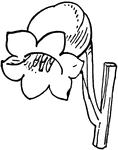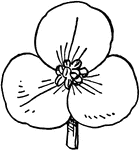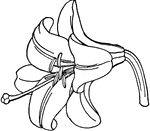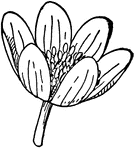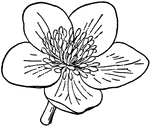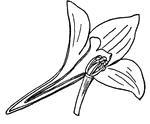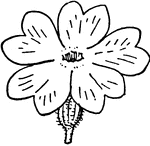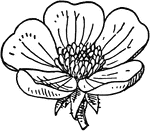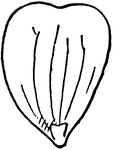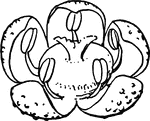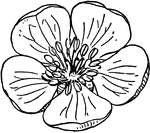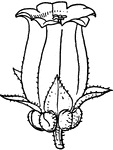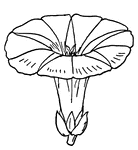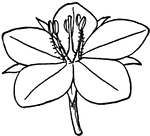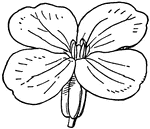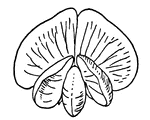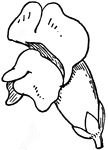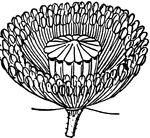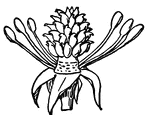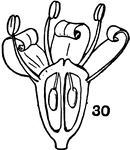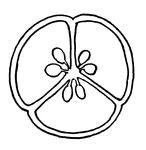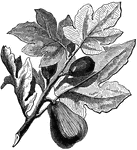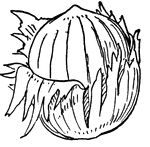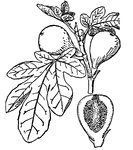
Fig
Any plant belonging to the genus Ficus is a fig. They are widely distributed in warm climates. Some…
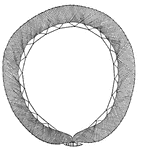
Purse-seine
A 'purse' seine is a form of fishing net that is paid out around a school of fish, like a cylinder with…

Gill-net
A net that catches fish with gill covers in the mesh of the net. This illustration shows a gill-net…

Figwort
This illustration shows a Figwort, a member of the genus Scrophularia. It has the characteristic features…

New Zealand Flax (Flowers)
New Zealand Flax is a liliaceous plant bearing tough, radical leaves, usually about four feet in length.…

New Zealand Flax (Fruit)
New Zealand Flax is a liliaceous plant bearing tough, radical leaves, usually about four feet in length.…
Form of Stamen
This illustration shows a form of a stamen, the part of a flower that holds pollen for reproduction.

Form of Stamen
This illustration shows a form of a stamen, the part of a flower that holds pollen for reproduction.

Form of Stamen
This illustration shows a form of a stamen, the part of a flower that holds pollen for reproduction.

Perigynous Stamens
Stamens of a flower that surround the rim of a cup or tube that surrounds the ovary, but is not attached…
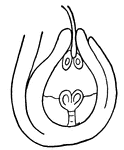
Fertilization (Flower)
This illustration shows the fertilization of a flower, by means of a pollen tube entering a micropyle,…

Fertilization (Flower)
This illustration shows fertilization of a flower, by means of pollen falling from stamens (male organ)…

Flowering Rush
A European plant which grows in stagnant or nearly stagnant water. It has long, sword-shaped leaves,…

Vertical Type Motor, Six Cylinder
This illustration shows a six cylinder motor and its many parts: Intake Manifold, Centrifugal Pump,…

Anzani Radial Motor, with Stationary Cylinders
This illustration shows an Anzani Radial Motor with stationary cylinders and its many parts: Exhaust…

V Type Motor, with Eight Cylinders
This illustration shows a V type motor with eight cylinders, fans, and many other parts: Gasoline Supply…
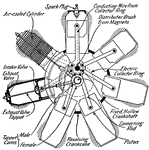
Gnome Motor, with Revolving Cylinders
This illustration shows a Gnome motor with revolving cylinders and its many parts: Spark Plug; Conducting…
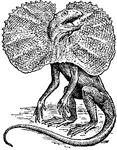
Frilled Lizard
Found in Oueensland and other parts of Australia, this lizard belongs to the family Agamidae. It reaches…
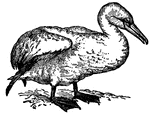
Gannet
Also known as a Solan Goose (Sula bassana), the Gannet is a large marine bird which nests in scattered…

Gentian
A genus of hardy plants, Gentians belong to the order Gentianaceae. They have a bitter taste, and one…

Geum Urbanum
Geum urbanum is a member of the genus Geum, a genus of hardy plants (Rosaceae). Not usually used decoratively,…

Ginger
Ginger is the dried rhizome of the tropical plant Zingiber officinale. It is used in cookery, because…

Glaux Maritima
Also known as Sea Milkwort, Glaux Maritima is a hardy perennial seashore plant belonging to the order…
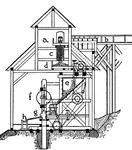
Stamp Mill for Gold Ores (Sectional View)
A stamp mill facilitates the crushing of ore (in this case, gold ore) into very small grains, with many…

British Golden-rod
British Golden-rod is a member of the large composite genus Solidago, which is chiefly North American.…
